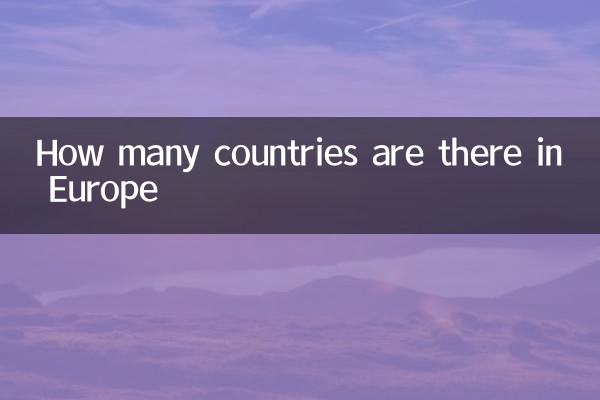How many countries are there in Europe
As one of the seven continents in the world, Europe is famous for its long history, diverse culture and unique geographical location. The question of how many countries there are in Europe seems simple, but there are different answers due to differences in politics, geography and sovereignty. This article will provide you with a detailed analysis of the number of countries in Europe and their classification based on the latest data.
1. Official identification of the number of European countries

According to official United Nations data, there are currently 44 sovereign states in Europe. Below is a list of European countries divided by geographical region:
| area | Number of countries | represent the country |
|---|---|---|
| Eastern Europe | 10 | Russia, Ukraine, Poland |
| Western Europe | 9 | France, Germany, Netherlands |
| Southern Europe | 15 | Italy, Spain, Greece |
| Nordic | 8 | Sweden, Norway, Finland |
| Others | 2 | Cyprus, Türkiye (part of the territory) |
2. Disputed areas and special cases
In addition to sovereign states, there are also some disputed areas or special political entities in Europe, which are usually not generally recognized by the international community:
| Name | Status | party claiming sovereignty |
|---|---|---|
| Kosovo | Partially recognized (100+ countries) | Serbia |
| Northern Cyprus | Only recognized by Türkiye | Cyprus |
| transnistria | not recognized | moldova |
3. Comparison of key data of European countries
The following is a comparison of core data for some European countries (based on 2023 statistics):
| country | Population (10,000) | Area (10,000 km²) | GDP (billion US dollars) |
|---|---|---|---|
| Russia | 14,300 | 1,712 | 18,300 |
| germany | 8,320 | 35.7 | 44,260 |
| Vatican | 0.08 | 0.00044 | Unannounced |
4. Relevance of recent hot topics
In the past 10 days, relevant hot spots in Europe have mainly focused on the following areas:
1.Progress of the Russia-Ukraine conflict: Ukraine formally submitted its application to join the European Union, triggering discussions on membership status
2.British royal family news:Polls show changes in support following Charles III's coronation
3.climate policy controversy: The official implementation of the EU carbon border tax triggered protests in many countries
4.Popularity of sports events: 2024 European Cup qualifiers hit record viewership
5. Supplementary explanation of geography and culture
It is worth noting:
• Transcontinental countries such as Türkiye and Georgia usually only count their European parts
• Micro-states such as Monaco and the Vatican are small but have complete sovereignty
• Greenland, an autonomous territory of Denmark, is not included as it belongs to North America
Summary:There are currently 44 sovereign states in Europe recognized by the United Nations, and the number is 45 if Kosovo, which is partially recognized, is included. This number will be adjusted as the political landscape changes. For example, since the disintegration of Yugoslavia in the 1990s, seven new countries have been added. Understanding the number of European countries requires a combination of historical background and contemporary international law, which is also a reflection of Europe's unique charm.

check the details

check the details